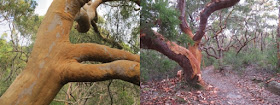You must consider a termitary as a single animal, whose organs have not yet been fused together as in a human being. Some of the termites form the mouth and digestive system; others take the place of weapons of defence like claws or horns; others form the generative organs.— Eugène Marais (1871 - 1936), The Soul of the White Ant, 1937.Not all social animals are social with the same degree of commitment.— Lewis Thomas (1913 - 1993), The Lives of a Cell, Penguin Books, 1978.
 |
| Termites and a nest |
 |
| Angophora costata, near Sydney |
Termites, white ants, are evil and destructive, no use at
all, right? Well, not quite. Ecologists see termites filling the same role in
our bush that the big herbivores of the African plains occupy. They clean up
hard-to-digest wood, converting it to soluble stuff with the assistance of
assorted microbes, amazing things, but termites have other uses.
 |
| Macrozamia plants. |
I have an
environmental education address to give in Dorrigo in June, and that got me
thinking about the poor quality land in the Myall Lakes National Park on the
east coast of Australia.
(Note added on posting: the address has now been given, and a version of it will appear here at some future time.)
(Note added on posting: the address has now been given, and a version of it will appear here at some future time.)
The Macrozamia
plants in the forest are more often found associated with the Smooth-barked
Apple or Rusty Gum (I wonder why it’s called that?), Angophora costata, than with the more common Blackbutt, Eucalyptus pilularis.
The reason for this is at once both complex and delightfully
simple.
As you can see from the pictures above, Angophoras are usually gnarled, with holes or hollows where branches
have broken off, and termites live in these trees, where they hollow out the
insides.
 |
| You can see the hollows after storms. |
 |
| Macrozamia seeds, with a 37 mm coin. |
Brushtail possums live in the hollows made by the termites. The
possums eat the orange outside of Macrozamia
seeds, and drop the partly eaten seeds around the base of their home trees.
The seeds germinate where they fall, which explains the
distribution of Macrozamia plants.
The roots of the Macrozamia 'fix'
nitrogen, and so improve the sandy soil the trees grow in. The trees then grow
better, providing more heartwood for the termites, who make more hollows for
the possums. Everything is connected!
The old settlers had another use for termite mounds:
In the course of this and the following day’s journey we passed many of the gigantic ant-hills common in some parts of New South Wales. They are great conical heaps of finely worked earth cemented into a hard mass, and from six to ten feet high, with no visible orifice outside, nor did I see a single ant about them, though I closely examined several. I have been told they are the work of a white ant, and, from their magnitude, should suppose them the habitation of a species of termite. When cut open, they display numerous small cells, but on our journey I had neither the time nor inclination to destroy and investigate their domestic arrangements myself. The earth of which these ant-hills are formed, is so finely prepared by the little architects that it is used by the settlers in the neighbourhood as plaster, and frequently as cement for floors.
— Louise Ann Meredith (Mrs Charles Meredith), Notes and Sketches of New South Wales. London: John Murray, 1844, and Ringwood: Penguin Books, 1973, pages 68-69.
Please be nice to termites!
(Some of the pictures used here: the Angophora stump, the Macrozamia plants and seeds were taken after this was written, just north of The Entrance on similar dunes near Lake Macquarie. It's the same set of associations, I think. The possum is from Brisbane City Council via Wikimedia Commons.)
General note that I am adding to some of my blog entries: I have lots of different interests. If some area interests you, look at the very end and you will see a set of tags called labels. These are hot links that will give you a list of other articles with the same tag/label.

Nice Post!
ReplyDelete